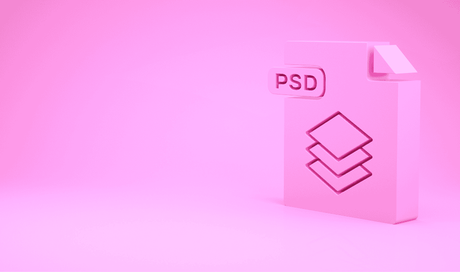
When it comes to computer graphic designing, one often encounters with various file formats. Among these, PSD stands out prominently. The PSD full form is Photoshop Document. This file format is the native format for Adobe Photoshop, a leading software in the realm of digital image editing. The PSD files are saved in .PSD extension for all PSD mockup, templates etc.
What is a PSD File?
A PSD file is a layered image that allows graphic designers to manipulate different elements of an image independently.
This format supports multiple layers, including text, images, and vector graphics, allowing for a non-destructive editing process. The flexibility of PSD files makes them a favorite among graphic designers, photographers, and digital artists.
Key Features of Photoshop Document Files
- Layer Management: One of the most significant advantages of PSD files is their support for multiple layers. This means users can edit individual components without affecting the whole image.
- High-Resolution Support: PSD files can handle high-resolution images, making them ideal for professional-grade prints and graphics.
- Various Color Modes: PSD files support different color modes, including RGB, CMYK, and grayscale, which is essential for both digital and print designs.
- Text and Vector Support: Text layers in PSD files remain editable, and vector shapes can be scaled without losing quality.
- File Size: Due to their comprehensive features, PSD files can be larger than other image formats like JPEG or PNG.
What Can You Create with PSD Files?
PSD files are incredibly versatile, making them a staple in graphic design and digital artistry. Here are some innovative creations you can make using PSD files:
- Digital Artwork: Artists often use PSD files to create detailed digital paintings and illustrations. The layered structure allows for easy manipulation of different elements, enhancing creativity.
- Photo Manipulations: Perfect for combining multiple images and effects. Designers can blend photos, apply filters, and adjust layers to create stunning photo montages and composites.
- Website and App Mockups: UI/UX designers frequently use to design website layouts and app interfaces. The ability to work with layers allows for the easy rearrangement of elements and the incorporation of visual assets.
- Print Materials: From business cards to brochures, PSD files are widely used to design print materials. The high-resolution support ensures that designs look sharp and professional when printed.
- Social Media Graphics: Marketers and content creators often design graphics for social media posts, covers, and ads using PSD files. The flexibility of layers allows for quick updates and changes.
- Digital Signage: Create eye-catching graphics for digital displays in retail environments, events, or presentations, ensuring effective message delivery.
- Branding Materials: Graphic designers can create logos, letterheads, and promotional items using PSD files. The ability to manipulate vector shapes and text layers aids in producing unique branding elements.
- Infographics: Can be utilized to design informative graphics that combine text and visuals, making complex information easy to understand.
- Animation Elements: While PSD files themselves are static, software like Adobe After Effects can animate them by animating individual layers separately.
- E-book Covers: Authors and publishers often create visually appealing e-book covers in PSD format, allowing for precise adjustments to images and text.
Common Software for Opening, Editing and Creating PSD Files
While Adobe Photoshop is the primary software for creating and editing PSD files, several other tools also support this format. Here are some notable options:
- Adobe Photoshop: The industry standard for image editing, Photoshop offers extensive tools and features for working with PSD files.
- GIMP: GIMP, a powerful, open-source alternative to Photoshop, can open and edit PSD files, though some advanced features may not be fully supported
- Affinity Photo: A cost-effective professional photo editing tool that supports PSD files, making it a popular choice among graphic designers.
- CorelDRAW: While primarily a vector graphic editor, CorelDRAW can import and work with PSD files.
- Photopea: An online photo editing tool that closely resembles Photoshop, Photoea allows users to edit PSD files directly in the browser.
- Paint.NET: A user-friendly image editing software that can open PSD files with the help of a plugin.
- Krita: Digital artists can use this open-source painting program to open and edit PSD files, offering a range of brushes and customizable features.
- Sketch: Primarily aimed at web and UI design, Sketch can import PSD files, allowing designers to manipulate layers and graphics effectively.
- Inkscape: While primarily a vector graphics editor, Inkscape can import PSD files and allows basic editing, making it useful for vector artists.
- Pixlr: An online photo editor with a user-friendly interface, Pixlr supports PSD files and provides various editing tools for quick adjustments.
- Microsoft Paint 3D: Although basic, this program can open PSD files and is useful for quick edits and 3D modeling tasks.
Conclusion
Anyone involved in graphic arts should understand the full form of PSD and its significance in the graphic design landscape.
With its robust features and compatibility with various software, PSD files offer unparalleled flexibility and control over image editing. Mastering PSD files and editing tools can enhance the creative workflow for both professional graphic designers and hobbyists.
In graphic designing industry, knowing PSD full form and its uses is a step closer. Embrace the power of layers, high-resolution images, and editable text to elevate your designs to new heights.
